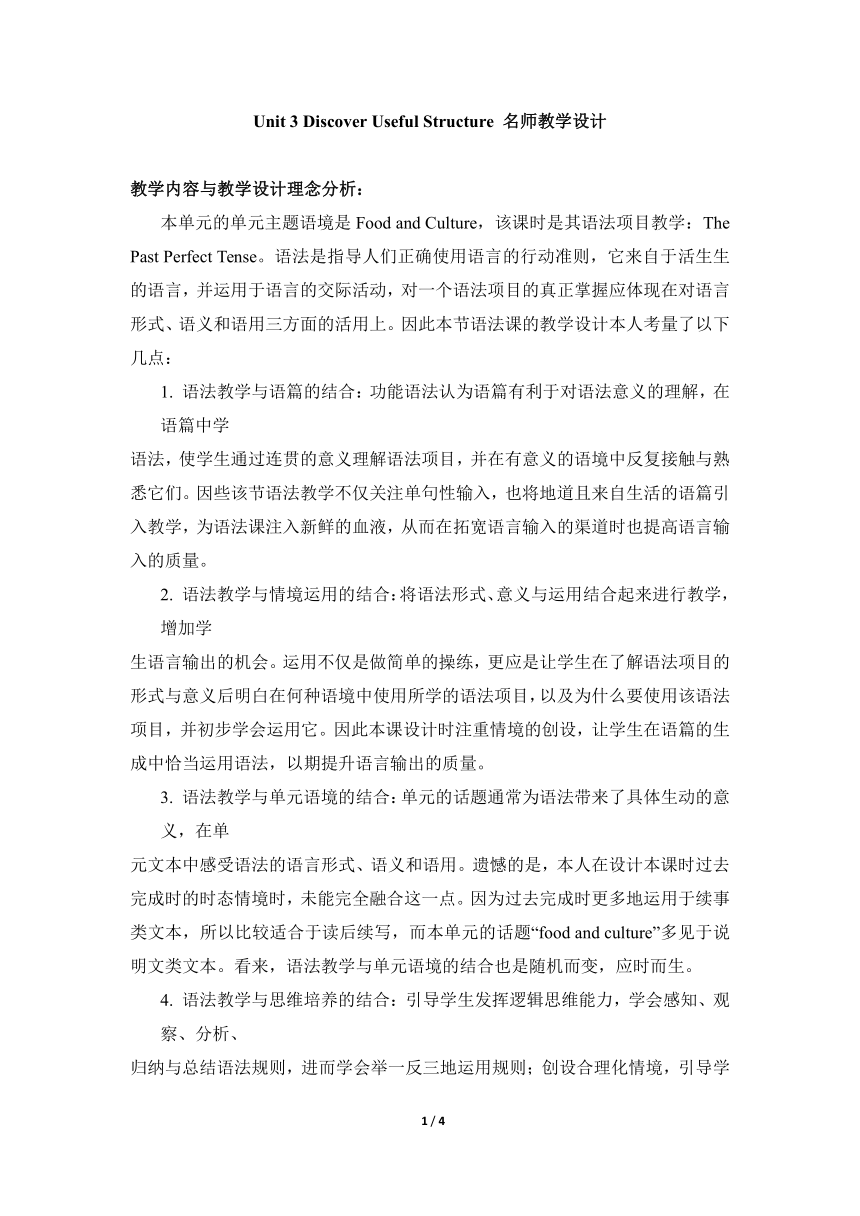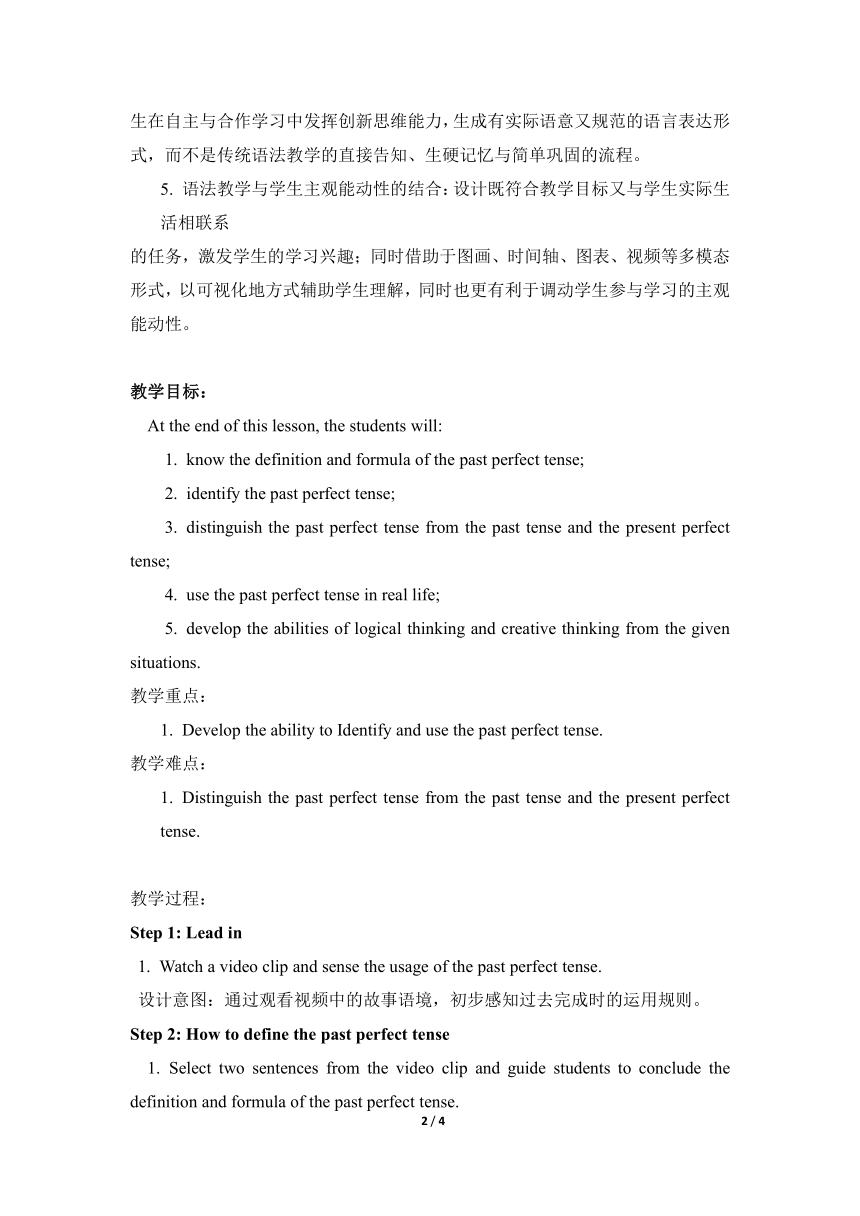人教版(2019)选择性必修第二册 Unit3 Food and Culture Discover Useful Structure 名师教学设计
文档属性
| 名称 | 人教版(2019)选择性必修第二册 Unit3 Food and Culture Discover Useful Structure 名师教学设计 |  | |
| 格式 | docx | ||
| 文件大小 | 230.6KB | ||
| 资源类型 | 教案 | ||
| 版本资源 | 人教版(2019) | ||
| 科目 | 英语 | ||
| 更新时间 | 2023-03-12 15:18:30 | ||
图片预览


文档简介
Unit 3 Discover Useful Structure 名师教学设计
教学内容与教学设计理念分析:
本单元的单元主题语境是Food and Culture,该课时是其语法项目教学:The Past Perfect Tense。语法是指导人们正确使用语言的行动准则,它来自于活生生的语言,并运用于语言的交际活动,对一个语法项目的真正掌握应体现在对语言形式、语义和语用三方面的活用上。因此本节语法课的教学设计本人考量了以下几点:
语法教学与语篇的结合:功能语法认为语篇有利于对语法意义的理解,在语篇中学
语法,使学生通过连贯的意义理解语法项目,并在有意义的语境中反复接触与熟悉它们。因些该节语法教学不仅关注单句性输入,也将地道且来自生活的语篇引入教学,为语法课注入新鲜的血液,从而在拓宽语言输入的渠道时也提高语言输入的质量。
语法教学与情境运用的结合:将语法形式、意义与运用结合起来进行教学,增加学
生语言输出的机会。运用不仅是做简单的操练,更应是让学生在了解语法项目的形式与意义后明白在何种语境中使用所学的语法项目,以及为什么要使用该语法项目,并初步学会运用它。因此本课设计时注重情境的创设,让学生在语篇的生成中恰当运用语法,以期提升语言输出的质量。
语法教学与单元语境的结合:单元的话题通常为语法带来了具体生动的意义,在单
元文本中感受语法的语言形式、语义和语用。遗憾的是,本人在设计本课时过去完成时的时态情境时,未能完全融合这一点。因为过去完成时更多地运用于续事类文本,所以比较适合于读后续写,而本单元的话题“food and culture”多见于说明文类文本。看来,语法教学与单元语境的结合也是随机而变,应时而生。
语法教学与思维培养的结合:引导学生发挥逻辑思维能力,学会感知、观察、分析、
归纳与总结语法规则,进而学会举一反三地运用规则;创设合理化情境,引导学生在自主与合作学习中发挥创新思维能力,生成有实际语意又规范的语言表达形式,而不是传统语法教学的直接告知、生硬记忆与简单巩固的流程。
语法教学与学生主观能动性的结合:设计既符合教学目标又与学生实际生活相联系
的任务,激发学生的学习兴趣;同时借助于图画、时间轴、图表、视频等多模态形式,以可视化地方式辅助学生理解,同时也更有利于调动学生参与学习的主观能动性。
教学目标:
At the end of this lesson, the students will:
know the definition and formula of the past perfect tense;
identify the past perfect tense;
distinguish the past perfect tense from the past tense and the present perfect tense;
use the past perfect tense in real life;
develop the abilities of logical thinking and creative thinking from the given situations.
教学重点:
Develop the ability to Identify and use the past perfect tense.
教学难点:
Distinguish the past perfect tense from the past tense and the present perfect tense.
教学过程:
Step 1: Lead in
Watch a video clip and sense the usage of the past perfect tense.
设计意图:通过观看视频中的故事语境,初步感知过去完成时的运用规则。
Step 2: How to define the past perfect tense
Select two sentences from the video clip and guide students to conclude the definition and formula of the past perfect tense.
【设计意图】:通过选用视频语境中的例子,并在时间轴的帮助下,引导学生观察并得出过
去完成时的定义。
Create a situation to invite students to think and share their ideas:
What gifts had the mission command prepared for the taikonauts on the Chinese New Year’s
Eve before they set off for outer space
【设计意图】:开放性的任务设计,一方面旨在让学生在实际情境中巩固过去完成时的形式结构,另一方面也激发学生的创新思维力和兴趣。
Combine two sentences into one using the past perfect tense.
【设计意图】:旨在让学生在运用中感受过去完成时的“过去的过去”的意义功能。
Step 3: How to identify the past perfect tense
Observe and conclude the ways to identify the past perfect tense.
Adverbial/conjunctive : by, by,before,when,until, since+ a past action/time
Adverbial: already, yet, just
Context: An action had happened before a past action/time
Drills: * had + hoped/wished/expected/thought/intended/meant/supposed
* It was the first/second… time + (that) sb. had done sth.
* “一……就……”:No sooner had sb. done than sb. did sth./
Hardly/Scarcely had sb. done when sb. did sth.
【设计意图】:通过对所给例句的观察和对知识点回顾练习等方式,帮助学生在语境中生成对过去完成时识别的方法。
Step 4: How to distinguish the past perfect tense from other tenses
Distinguish the past perfect tense from the past tense.
Distinguish the past perfect tense from the present perfect tense.
【设计意图】:通过对所给例句的观察和时间轴的可视化辅助,帮助学生区别混淆性很大的一般过去时与现在完成时。
3. Fill in the blanks.
4. Give the correct forms of the verbs. If necessary, draw a time axis to help you.
【设计意图】:在语篇和单句中理解与运用过去完成时及其易混淆性时态的区分。
Step 5: How to use the past perfect tense
1. Create your sentences with the past perfect tense.
Example: Claire looked very happy when I saw her last week.
(Possible answer: She had released her first album.)
【设计意图】:过去完成时在单句语境创设中的运用,既是对该时态运用的进一步巩固,
也有利于学生创新性思维的培养。
2. Create your version about the love story between Jake and Ann, which is an embarrassing
yet happy-ending story. Use the past perfect tense when necessary.
Invite students to share their versions.
Watch the unfinished part of the video clip broadcast at the beginning of the class.
【设计意图】:通过语篇情境的写作任务,让学生充分发挥想象,既培养学生运用语法解
决问题的能力,也有利于培育学生的创新思维能力,同时也在饶有兴趣的情境中引发学生参与活动的主观能动性。
Step 6: Homework
Create a mini story about one of the pictures. Use the past perfect tense when necessary.
2 / 2
教学内容与教学设计理念分析:
本单元的单元主题语境是Food and Culture,该课时是其语法项目教学:The Past Perfect Tense。语法是指导人们正确使用语言的行动准则,它来自于活生生的语言,并运用于语言的交际活动,对一个语法项目的真正掌握应体现在对语言形式、语义和语用三方面的活用上。因此本节语法课的教学设计本人考量了以下几点:
语法教学与语篇的结合:功能语法认为语篇有利于对语法意义的理解,在语篇中学
语法,使学生通过连贯的意义理解语法项目,并在有意义的语境中反复接触与熟悉它们。因些该节语法教学不仅关注单句性输入,也将地道且来自生活的语篇引入教学,为语法课注入新鲜的血液,从而在拓宽语言输入的渠道时也提高语言输入的质量。
语法教学与情境运用的结合:将语法形式、意义与运用结合起来进行教学,增加学
生语言输出的机会。运用不仅是做简单的操练,更应是让学生在了解语法项目的形式与意义后明白在何种语境中使用所学的语法项目,以及为什么要使用该语法项目,并初步学会运用它。因此本课设计时注重情境的创设,让学生在语篇的生成中恰当运用语法,以期提升语言输出的质量。
语法教学与单元语境的结合:单元的话题通常为语法带来了具体生动的意义,在单
元文本中感受语法的语言形式、语义和语用。遗憾的是,本人在设计本课时过去完成时的时态情境时,未能完全融合这一点。因为过去完成时更多地运用于续事类文本,所以比较适合于读后续写,而本单元的话题“food and culture”多见于说明文类文本。看来,语法教学与单元语境的结合也是随机而变,应时而生。
语法教学与思维培养的结合:引导学生发挥逻辑思维能力,学会感知、观察、分析、
归纳与总结语法规则,进而学会举一反三地运用规则;创设合理化情境,引导学生在自主与合作学习中发挥创新思维能力,生成有实际语意又规范的语言表达形式,而不是传统语法教学的直接告知、生硬记忆与简单巩固的流程。
语法教学与学生主观能动性的结合:设计既符合教学目标又与学生实际生活相联系
的任务,激发学生的学习兴趣;同时借助于图画、时间轴、图表、视频等多模态形式,以可视化地方式辅助学生理解,同时也更有利于调动学生参与学习的主观能动性。
教学目标:
At the end of this lesson, the students will:
know the definition and formula of the past perfect tense;
identify the past perfect tense;
distinguish the past perfect tense from the past tense and the present perfect tense;
use the past perfect tense in real life;
develop the abilities of logical thinking and creative thinking from the given situations.
教学重点:
Develop the ability to Identify and use the past perfect tense.
教学难点:
Distinguish the past perfect tense from the past tense and the present perfect tense.
教学过程:
Step 1: Lead in
Watch a video clip and sense the usage of the past perfect tense.
设计意图:通过观看视频中的故事语境,初步感知过去完成时的运用规则。
Step 2: How to define the past perfect tense
Select two sentences from the video clip and guide students to conclude the definition and formula of the past perfect tense.
【设计意图】:通过选用视频语境中的例子,并在时间轴的帮助下,引导学生观察并得出过
去完成时的定义。
Create a situation to invite students to think and share their ideas:
What gifts had the mission command prepared for the taikonauts on the Chinese New Year’s
Eve before they set off for outer space
【设计意图】:开放性的任务设计,一方面旨在让学生在实际情境中巩固过去完成时的形式结构,另一方面也激发学生的创新思维力和兴趣。
Combine two sentences into one using the past perfect tense.
【设计意图】:旨在让学生在运用中感受过去完成时的“过去的过去”的意义功能。
Step 3: How to identify the past perfect tense
Observe and conclude the ways to identify the past perfect tense.
Adverbial/conjunctive : by, by,before,when,until, since+ a past action/time
Adverbial: already, yet, just
Context: An action had happened before a past action/time
Drills: * had + hoped/wished/expected/thought/intended/meant/supposed
* It was the first/second… time + (that) sb. had done sth.
* “一……就……”:No sooner had sb. done than sb. did sth./
Hardly/Scarcely had sb. done when sb. did sth.
【设计意图】:通过对所给例句的观察和对知识点回顾练习等方式,帮助学生在语境中生成对过去完成时识别的方法。
Step 4: How to distinguish the past perfect tense from other tenses
Distinguish the past perfect tense from the past tense.
Distinguish the past perfect tense from the present perfect tense.
【设计意图】:通过对所给例句的观察和时间轴的可视化辅助,帮助学生区别混淆性很大的一般过去时与现在完成时。
3. Fill in the blanks.
4. Give the correct forms of the verbs. If necessary, draw a time axis to help you.
【设计意图】:在语篇和单句中理解与运用过去完成时及其易混淆性时态的区分。
Step 5: How to use the past perfect tense
1. Create your sentences with the past perfect tense.
Example: Claire looked very happy when I saw her last week.
(Possible answer: She had released her first album.)
【设计意图】:过去完成时在单句语境创设中的运用,既是对该时态运用的进一步巩固,
也有利于学生创新性思维的培养。
2. Create your version about the love story between Jake and Ann, which is an embarrassing
yet happy-ending story. Use the past perfect tense when necessary.
Invite students to share their versions.
Watch the unfinished part of the video clip broadcast at the beginning of the class.
【设计意图】:通过语篇情境的写作任务,让学生充分发挥想象,既培养学生运用语法解
决问题的能力,也有利于培育学生的创新思维能力,同时也在饶有兴趣的情境中引发学生参与活动的主观能动性。
Step 6: Homework
Create a mini story about one of the pictures. Use the past perfect tense when necessary.
2 / 2
